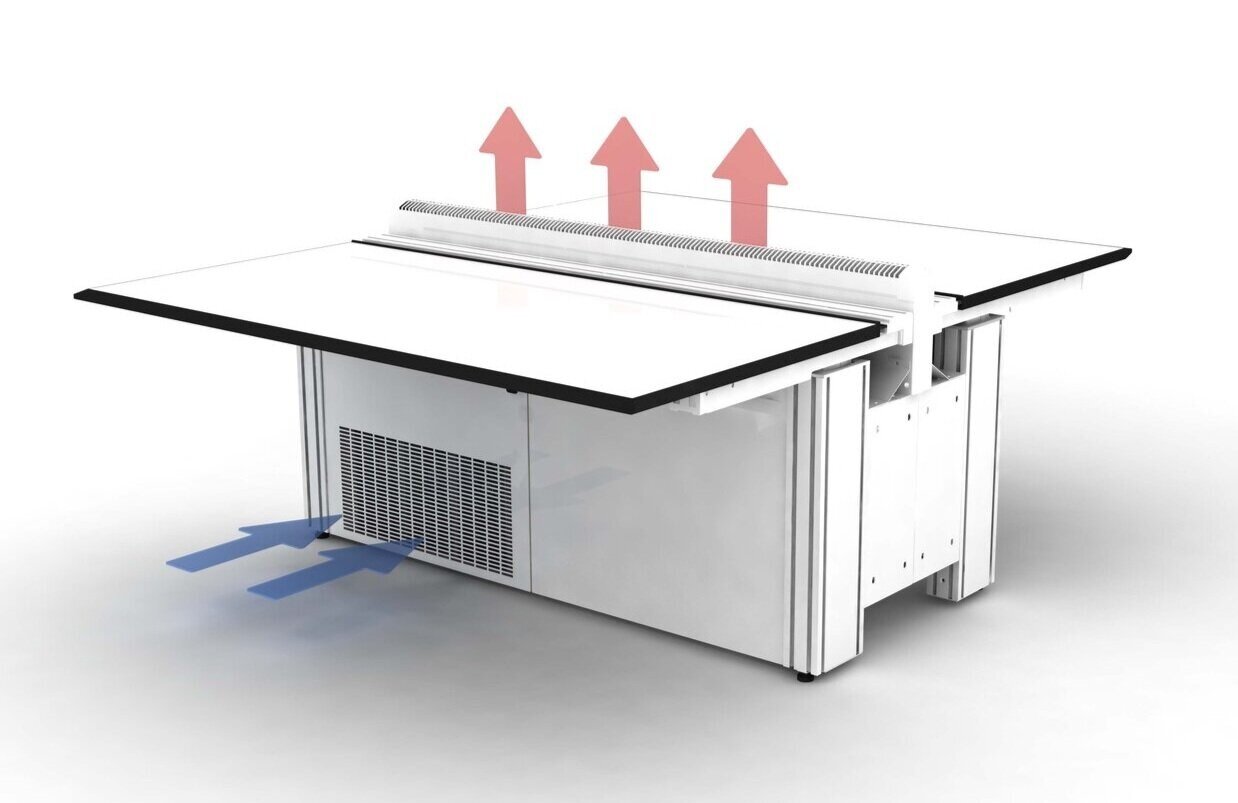Staying cool under pressure: A look at trading desk heat management
Traders and control room operators both work long hours under considerable pressure. They often use multiple PCs to process large volumes of data, too. These can generate a lot of heat, which becomes uncomfortable if it isn’t properly managed. Effective desk heat management is crucial, and below-desk PC cabinets must be designed to expel the hot air.
A temperature controlled in-desk cabinet improves comfort levels, helping you concentrate. If you're working in a high-pressure role it'll help you stay focused on long shifts.
CFD test showing cool air entering the 2 x PC inlets from below (ambient temp ≈23°C) and hot air being exhausted via the rear of the PCs ( ≈40°C).
Independently tested and certified
The demand for higher capacity processors has meant greater heat output. Technology Desking's response has been to refine the heat management components of our Continuum desk range. We also commissioned independent testing by the Building Research Establishment (BRE).
The tests proved that even with a maximum thermal load of 2400 Watts, Continuum's heat management components prevented CPUs from overheating. They also maintained a comfortable temperature and air velocity for the user.
Engineered for heat management
Our Continuum desks have a purposely designed desk flue to eject hot air from PCs by natural convection. The PC's CPU fan draws air in through the cabinet door. The air then cools the CPU fans and is expelled from the flue at the back of the PC. Insulation prevents the heat from being radiated out onto the user.
Additional heat management options can further aid the heat management process. These include:
Natural convection cooling (vented door)
Active convection cooling (fan assisted door or flue)
Forced air cooling (air sealed desk)
Forced air cooling is a temperature control method where a swirl diffuser on the floor pumps chilled air. The desk void is sealed (Continuum desks are supplied with an air sealing kit to accommodate this). The cool air enters the PC inlet (usually located at the front of the PC) and also mixes with the hot air exhausted from the CPU fans. This cools the air around the PCs and lowers the temperature of air ejected from the desk.
Automatic temperature control
To assist the natural convection process, we can add 12Vdc fans to the left-hand vented door, central desk flue or cabinet exhaust venting. The door fans lower the operating temperature of CPUs (being located in front of the PC inlet), and in turn the air ejected from the desk.
You can also use a thermal controller with the door fans. This automatically controls the fans' speed relative to the desk void's temperature by locating a thermistor at a desired location within the desk void.
CFD showing air that is assisted by rack mounted fans. Side view with room ambient at 30°c and 3 x CPUs running at 35°c.
A display on the thermal controller shows void temperature and fan speed. It also has an alarm feature that sounds if the desk void reaches a pre-set temperature.
Fan assisted desk void with thermal controller
Ventilation options
Below desk IT cabinets need good ventilation to prevent CPUs from overheating and shutting down. Continuum cabinets are also constructed from steel, which disperses heat better than wood or particle board.
Inlet ventilation slots on the front or base of the cabinet and outlet slots at the rear desk flue allow the heat to dissipate. Forced convection with fans assist the natural convection process.
Heat management throughout the day
Heat management is an integral feature of a control room console or trading desk. Continuum desks have been optimised within laboratory conditions. They can manage heat even in the most testing environments.
Our solutions range from standard desk flue ventilation options to sophisticated in-desk fans. Your team can feel comfortable knowing their workstations will remain at a safe and functional temperature.
All our in-desk PC housing undergoes heat management testing using Computational Fluid Dynamics (CFD) software. Technology Desking can also carry out real-life heat management testing at our showroom locations. We are able to test desks that incorporate client specification PCs.
Are you looking for a desk with sophisticated heat management for your control room or trading floor? Visit our showroom or get in touch to find out more!





